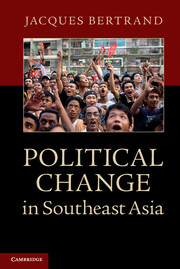Book contents
- Frontmatter
- Contents
- List of figures and tables
- Preface
- 1 Understanding political change in Southeast Asia
- Part I Capitalism, economic growth and political change
- Part II State-socialist countries and authoritarian stability
- 6 Vietnam
- 7 Cambodia and Laos
- 8 Burma/Myanmar
- 9 Southeast Asia in the twenty-first century
- References
- Index
9 - Southeast Asia in the twenty-first century
Published online by Cambridge University Press: 05 June 2014
- Frontmatter
- Contents
- List of figures and tables
- Preface
- 1 Understanding political change in Southeast Asia
- Part I Capitalism, economic growth and political change
- Part II State-socialist countries and authoritarian stability
- 6 Vietnam
- 7 Cambodia and Laos
- 8 Burma/Myanmar
- 9 Southeast Asia in the twenty-first century
- References
- Index
Summary
Southeast Asia in the twenty-first century is a region of contrasts and rapid transformation. Propelled by high growth rates during several decades, many countries of the region have risen from poor to relatively wealthy ones. Singapore, Malaysia, Thailand and Indonesia have modernized rapidly. Their urban areas have expanded and the middle class has grown. Other countries, by contrast, have lagged well behind. The Philippines grew less impressively overall but more steadily in recent years. Wealth inequality remains higher than that of its more prosperous neighbours. Vietnam, Cambodia, Myanmar (Burma) and Laos were left behind. Decades of experimentation with central planning and socialist policies failed to significantly raise living standards. Although the poorest gained minimum safety nets, overall wealth only slowly increased and therefore most of the population remained much poorer than in other parts of the region. The Vietnam War brought further destruction and instability in Vietnam, Laos and Cambodia while civil war in the latter continued to perpetuate destruction and poverty. Vietnam in the 1990s and 2000s began to grow much more rapidly as it implemented market reforms and allowed more critical examination of failed policies of the past. Laos followed suit with its own reforms. Myanmar's radical and ideologically motivated armed forces long prevented its population from prospering. In fact, it was one of the only countries to have several periods of economic setbacks, largely induced by the regime's policies. Recent changes are beginning to produce some results but the country remains far behind others.
- Type
- Chapter
- Information
- Political Change in Southeast Asia , pp. 209 - 228Publisher: Cambridge University PressPrint publication year: 2013



